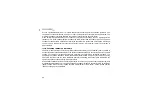
25
At such elevated temperatures, it is recommended that the user perform a calibration procedure on a
sample piece of known thickness, which is at, or near, the temperature of the material to be measured. This
will allow the gauge to correctly calculate the velocity of sound through the hot material.
When performing measurements on hot surfaces, it may also be necessary to use a high-temperature
transducer. It is recommended that the transducer be left in contact with the surface for as short a time as
needed to acquire a stable measurement. While the transducer is in contact with a hot surface, it will begin
to heat up, and through thermal expansion and other effects, may adversely affect the accuracy of
measurements.
15.3 MEASURING LAMINATED MATERIALS
The density (and therefore sound-velocity) of laminated materials may vary considerably from one piece to
another. Some laminated materials may even exhibit noticeable changes in sound-velocity across a single
surface. The only way to reliably measure such materials is by performing a calibration procedure on a
sample piece of known thickness. Ideally, this sample material should be a part of the same piece being
measured, or at least from the same lamination batch. By calibrating to each test piece individually, the
effects of variation of sound-velocity will be minimised.
An additional consideration when measuring laminates, is that any air gaps or pockets within the laminate
will reflect the ultrasound beam. This will be noticed as a sudden increase in sound-velocity in an otherwise
regular surface. While this may impede accurate measurement of the material, it does provide positive
indication of air gaps in the laminate.


































